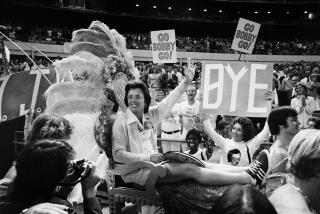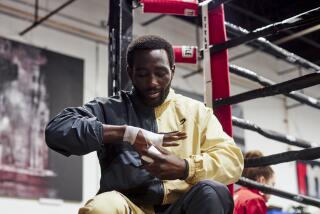Emile Griffith dies at 75; champion boxer struggled with his sexuality
- Share via
Emile Griffith, a former world welterweight and middleweight boxing champion who spent decades haunted by his fatal beating of then-champion Benny Paret in the ring and bothered by the public’s interest in his sexuality, died Tuesday. He was 75.
Griffith’s death at an extended-care facility in Hempstead, N.Y., was announced by the International Boxing Hall of Fame, where he was inducted in 1990 following an 85-24-2 career that counted 23 main events at Madison Square Garden and victories over middleweight champions Dick Tiger and Nino Benvenuti.
“He was a man’s man in the world of boxing but his own person out in the world,” said Griffith’s friend and biographer, Ron Ross, whose book on the fighter, “Nine… Ten… and Out! The Two Worlds of Emile Griffith,” was published in 2008.
“It was difficult to get into details with Emile. To the end, he would not want to make himself so open to everyone,” Ross said. “He didn’t like to be labeled gay and still felt the world was not ready for Emile Griffith.”
Though Griffith had been bedridden, limited to tube feeding for the last two years, the time has been marked by the prominent disclosures of two athletes, boxer Orlando Cruz and former NBA player Jason Collins, that they are gay.
Cruz, preparing for an Oct. 12 world featherweight title fight, had attempted in recent months to schedule a meeting with Griffith that never happened.
“Emile would be very pleased and accepting of these athletes,” Ross said. “He had his own set of rules for life, and he felt people can live their lives the way they wanted to.”
Griffith was born Feb. 3, 1938, in St. Thomas, the Virgin Islands. He was working as a stock boy handling women’s hats at a New York garment factory when factory executive and boxing manager Howie Albert noticed his physique and coaxed him to work out for famed boxing trainer Gil Clancy.
Griffith was a fast-punching, deceptive fighter whose personal joy shined through even in tough matchups such as a 1965 venture into the home arena of Fresno’s Gabe Terronez, a bout that Griffith won easily by fourth-round knockout.
But the boxer found a foil in Cuba’s Benny “Kid” Paret. Griffith knocked out Paret in the 13th round of their April 1961 bout, and Paret responded with a split-decision triumph five months later.
That set the stage for their third bout, at Madison Square Garden in March 1962, when Paret inflamed Griffith by insulting him with a slur, which Sports Illustrated described as “gutter Spanish for homosexual.”
Clancy had to take Griffith for a walk around New York following the weigh-in to help him cool off. Griffith told Ross: “There was never hatred, but I was very angry.”
In the 1962 Sports Illustrated account, Gilbert Rogin wrote: “It is the most vulgar epithet in that violent idiom and is particularly galling to Griffith, who has a piping voice, wears extravagantly tight clothes, has designed women’s hats and is, ordinarily, a charming, affectionate kid.”
Griffith told Ross he meant to win the fight by knockout, “but I never intended to harm Benny Paret.”
Griffith controlled the fight before Paret scored a quick knockdown in the eighth round. Griffith rallied and cornered Paret in the 12th.
Sports Illustrated reported: “Suddenly, Emile battered Paret with a plangent right. This time, Griffith resolved to finish him. He began belaboring the suffering Paret with right uppercuts, one after another, an unrelenting fusillade, Emile’s hand banging against Benny’s jaw as remorselessly as the clapper of a great, dark bell. Paret sagged back against the middle turnbuckle. Griffith’s punches drove his head out between the top and middle strands....
“Benny was helpless, bleeding from his nose and a cut on his right cheek; his puffed eyes were closed,” Sports Illustrated reported. “Still Griffith punched him, with mounting and maniacal rage, as though determined, literally, to wipe out both Paret and the memory of his taunt. There were, in all, about 15 uppercuts, followed by several hooks.”
Griffith said later: “When I saw Paret hurt, I wanted him to be on the ground before the fight was stopped. I wanted to keep punching. I was still eager to put him down.”
Referee Ruby Goldstein finally stopped the fight.
Paret died 10 days later.
Upset but resigned to the fact that boxing was his profession, Griffith returned to the ring and fought until 1977, losing a welterweight title fight to Luis Rodriguez at Dodger Stadium in 1963.
The scar of his rage and the death of Paret stayed with Griffith for decades.
“He’d wake up at night and see Benny Paret at the foot of his bed,” Ross said.
A 2005 documentary about the fight and Griffith, “Ring of Fire,” featured a healing meeting between Griffith and Paret’s son, Benny Jr., but Paret’s wife, Lucia, refused to acknowledge Griffith at the documentary premiere.
In an interview afterward with the New York Times, Griffith acknowledged sexual relations with men and women.
He had a long relationship in the 1990s with Luis Rodrigo Griffith, a young man whom he later adopted.
Griffith married a woman, Mercedes Donastorg, in 1971, divorced soon after and told Ross he preferred physical relations with women “but felt more comfortable with men, and could confide in them.”
Outside a New York gay bar in 1992, Griffith was severely beaten by at least five men who mugged him with bats and chains, leading him to a later life of dementia, Ross said.
“By 2009, there was no more intelligent conversation,” Ross said. “His passing is a blessing. I visited him three weeks ago. It was just so sad to see him like that, knowing he had this tremendous athleticism and instinctive skills once. He could do anything — play tennis, dance, sing. He never wanted to be a fighter.”
Griffith is survived by his son, Luis, and brothers Franklin, Tony and Guillermo, and sisters Eleanor, Karen, Joyce and Gloria.
More to Read
Start your day right
Sign up for Essential California for the L.A. Times biggest news, features and recommendations in your inbox six days a week.
You may occasionally receive promotional content from the Los Angeles Times.







